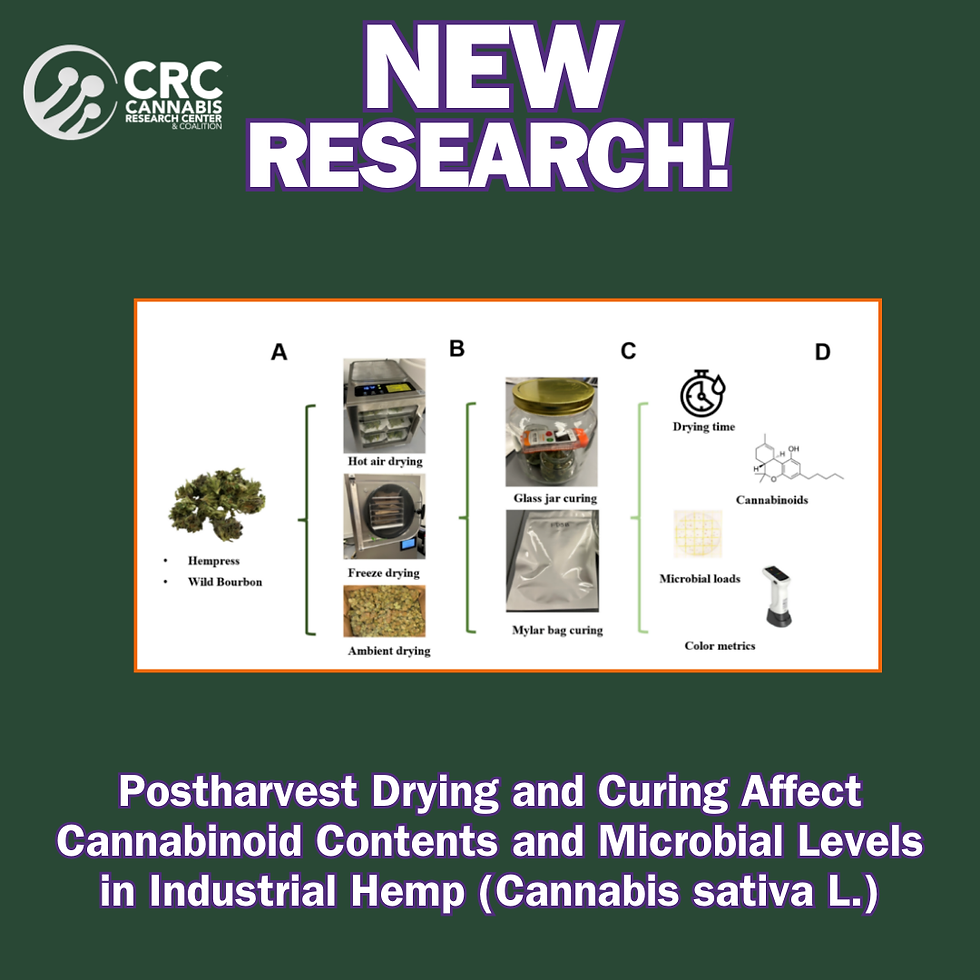NEW RESEARCH! The role of Red and White light in optimizing growth and accumulation of plant secondary metabolites at two light intensities in medical cannabis
- Ashley Manning

- Jan 2
- 2 min read
authors: Mexximiliaan M. S. F. Holweg, Elias Kaiser, Iris F. Kappers Ep Heuvelinkand Leo F. M. Marcelis
Horticulture and Product Physiology, Wageningen University, Wageningen, Netherlands, Laboratory of Plant Physiology, Wageningen University, Wageningen, Netherlands
CORRESPONDENCE Mexximiliaan M. S. F. Holweg
mexx.holweg@wur.nl Leo F. M. Marcelis leo.marcelis@wur.nl

Practical Breakdown
It is well established in horticultural crops that light spectrum plays a pivotal role in plant development. In controlled environment agriculture, cultivators use various light spectrums to manipulate crop growth and productivity.
This study aimed to assess the effects of different LED PAR (Photosynthetically Active Radiation) spectrums on cannabis growth and secondary metabolite production. Using a single Type-II cannabis variety, the experiment was conducted in growth chambers with four distinct lighting treatments. The spectral properties of these treatments are summarized in the table below.
One of the LED sources, labelled as 6B-19G-75R/2 Peaks, was unique in that it emitted two spectral peaks within the red spectrum: one at 640 nm and another at 660 nm. These wavelengths closely align with the peak photon absorption ranges of Chlorophyll-b (642 nm) and Chlorophyll-a (663 nm), respectively.
The rationale behind this dual-peak red spectrum is its potential to enhance photosynthetic efficiency. By simultaneously energizing both chlorophyll types in leaf tissue, the overall photosynthetic rate could be increased. This higher photo-assimilative capacity is hypothesized to translate into improved yields and potentially greater secondary metabolite production.
During the experiment, both destructive and non-destructive measurements were taken to evaluate morphological and physiological parameters. These assessments were performed under two light intensity conditions: low light (600 µmol m²/s) and high light (1200 µmol m²/s). This approach was designed to investigate the interactive effects of light intensity and spectral distribution.
Key Findings
1. At both low and high light intensities (PPFD), the LED type 6B-19G-75R/2, featuring a white spectrum with dual red peaks, produced the highest inflorescence weight among all four LEDs. Furthermore, this dual red peak spectrum led to an increase in overall terpenoid concentrations.
2. This study did not observe any significant effects of light intensity or spectral distribution on overall cannabinoid concentrations.
3. The highest incidence of bleached flowers due to excessive light intensities was observed under the dual red peak spectrum LED (6B-19G-75R/2). Interestingly, the bleached flowers exhibited significantly elevated levels of CBD compared to non-bleached flowers. This phenomenon may be attributed to the antioxidative properties of CBD, which could act as a protective mechanism against reactive oxygen species (ROS).
Application For Cultivators
1- When selecting a lighting source for controlled environment agriculture, it is crucial to consider both the quantum flux (light intensity) and the spectral distribution of the light.
2- A light source with spectral peaks in the red range, particularly near 640 nm and 660 nm, can enhance cannabis dry flower yields. However, these red spectral peaks can increase the risk of light damage (photobleaching) at higher light intensities for certain strains. This requires careful management to ensure product quality remains unaffected.
3- Lighting sources with a rich green spectrum can help mitigate the effects of high light levels that may lead to photobleaching. Green light, due to its ability to penetrate deeper into the plant canopy, promotes more uniform intra-canopy light distribution, which can reduce stress and improve overall plant health.
DOWNLOAD FULL PUBLICATION
.png)


Comentarios